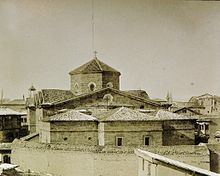Architectural type Church Region Central Anatolia Region | Heritage designation None | |
 | ||
Ecclesiastical or organizational status Destroyed by the Turkish army Status Ceased functioning as a monastery in 1915 Similar Krtsanis Tsiranavor Surp Astv, Saint Hakob Church of, Cathedral of Arapgir, Kotavank, Arshakid Mausoleum | ||
The Monastery of Sourb Nshan of Sebastia (Armenian: Սուրբ Նշան վանք Սեբաստիո) is a former Armenian monastic complex near the city of Sivas in Turkey.
Contents
Name
"Sourb Nshan" in Armenian for Holy Sign. Sebastia was the historical name of the city of SivasThe Monastery of Sourb Nshan of Sebastia is a former Armenian monastic complex near the city of Sivas in Turkey
History
Sourb Nshan monastery was established by prince Atom-Ashot, the son of King Senekerim. The monastery was named after a celebrated relic that Senekerim had brought from Varagavank monastery, and which was returned there after his death. This was one of notable center of enlightenment and scholarship of Lesser Armenia during Byzantine, Seljuk Sultanate of Rum and Ottoman reigns until the Armenian Genocide in 1915. In 1915 Sourb Nshan monastery was the main repository of medieval Armenian manuscripts in the Sebastia region and at least 283 manuscripts are recorded. The library was not destroyed during World War I and most of the manuscripts survived. In 1918 about 100 of them were transferred to the Armenian Patriarchate in Jerusalem.
Current condition
The monastery today is entirely destroyed and a sprawling military base occupies the site. The date of the destruction is uncertain. The monastery stood on a low hill overlooking Sivas and was surrounded by a plain and undefended outer wall. On one side of that enclosure wall, encircled by a wall of mud brick, was a large garden containing fruit trees and vegetable plots. Several farms were also attached to the monastery.
Appearance
The monastery had three churches – their names were Sourb Astvatsatsin (Armenian: Սուրբ Աստվածածին) (Holy Mother of God), Sourb Khatch (Armenian: Սուրբ Խաչ) (Holy Cross), and Sourb Hovhannes Karapet (Armenian: Սուրբ Հովհաննես Կարապետ) (Saint John the Precursor).
